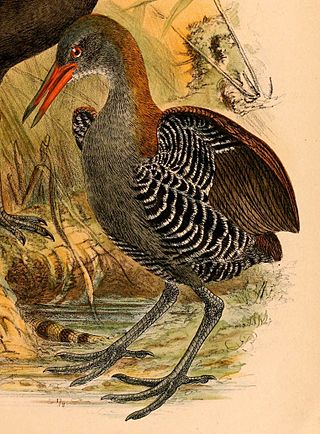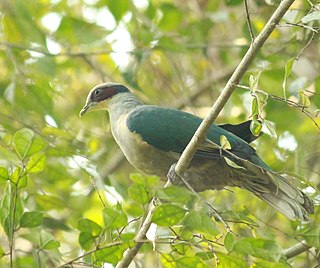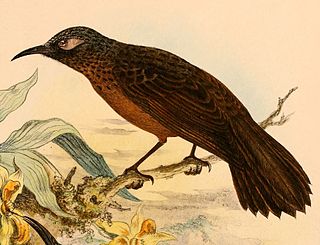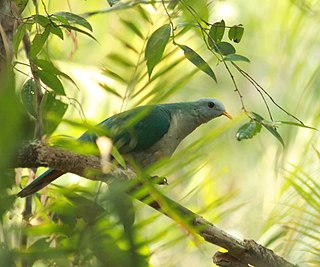
The jambu fruit dove is a smallish colourful fruit dove. It is a resident breeding species in southern Thailand, Malaysia, Brunei and the Indonesian islands of Kalimantan, Sumatra and Java.

The Halmahera paradise-crow also known as the silky crow, is a medium-sized crow-like bird-of-paradise.

The golden bowerbird is a species of bird in the family Ptilonorhynchidae, the bowerbirds. It is endemic to Queensland in Australia, where it is limited to the Atherton region.

The Key West quail-dove is a species of bird from the doves and pigeon family Columbidae. It is probably most closely related to the bridled quail-dove.

The snoring rail, also known as the Celebes rail or Platen's rail, is a large flightless rail and the only member of the genus Aramidopsis. The species is endemic to Indonesia, and it is found exclusively in dense vegetation in wet areas of Sulawesi and nearby Buton. The rail has grey underparts, a white chin, brown wings and a rufous patch on the hind-neck. The sexes are similar, but the female has a brighter neck patch and a differently coloured bill and iris. The typical call is the snoring: ee-orrrr sound that gives the bird its English name.

The knobbed hornbill, also known as Sulawesi wrinkled hornbill, is a colourful hornbill native to Indonesia. The species is sometimes placed in the genus Aceros. The knobbed hornbill is the faunal symbol of South Sulawesi province.

The black-eared wood quail is a bird species in the order Galliformes. Until recently, the species was thought to be part of the family Phasianidae however DNA-DNA hybridization results determined that black-eared wood quail are only distantly related to Old World quail. As a result, black-eared wood quail have been placed in the family Odontophoridae and more specifically, in the category of wood quail.

The golden-mantled racket-tail is a species of parrot in the family Psittaculidae. It is endemic to Indonesia. Its natural habitats are subtropical or tropical moist lowland forest and subtropical or tropical moist montane forest up to an altitude of about 3,000 metres (9,800 ft).

The Micronesian imperial pigeon, also known as the Micronesian pigeon, and Belochel is a species of bird in the family Columbidae (doves). It is found in Palau, the Caroline Islands, the Marshall Islands and Nauru. Its habitats include montane forests, secondary forests, forests on beaches, and mangroves. It is threatened by hunting and deforestation, and the IUCN has assessed it as a near-threatened species.

The New Britain bronzewing is a species of bird in the family Columbidae. It is endemic to Papua New Guinea. In 1988, it was rated as a near threatened species on the International Union for Conservation of Nature Red List of Endangered Species. However, in 2000, it was warranted a vulnerable status.

Mackinlay's cuckoo-dove, also known as the spot-breasted cuckoo-dove, is a species of bird in the family Columbidae. It is found in Papua New Guinea, Solomon Islands, and Vanuatu. It is rated as a species of least concern on the International Union for Conservation of Nature Red List of Endangered Species.

The little cuckoo-dove is a species of bird in the family Columbidae. It is a reddish brown pigeon, and is found in Brunei, China, Indonesia, Laos, Malaysia, Myanmar, Thailand, and Vietnam. It is rated as a species of least concern on the International Union for Conservation of Nature Red List of Endangered Species.

The Negros fruit dove is a species of bird in the pigeon and dove family, Columbidae. It is endemic to the island of Negros in the Philippines. This fruit dove is known from a single female specimen collected from the slopes of Mount Kanlaon in the northern part of the island. While it was found at a high elevation, it is suspected that the species originally lived in the lowland dipterocarp forests and was driven to higher elevations by habitat destruction. While some have suggested that the specimen is either a runt or a hybrid instead of a valid species, this is not widely accepted. The female Negros fruit dove was a small fruit dove with vivid dark green plumage and an ashy-grey forehead. It had a distinctive ring of bare yellow skin around its eye, and yellow fringes to some of its feathers gave it the appearance of having a yellow wingbar when perched. The throat was white, while the undertail and vent were yellow.

The red-eared fruit dove is a species of bird in the pigeon family. It is endemic to the island of Sulawesi, Indonesia.

The red-moustached fruit dove is an extinct species of bird in the family Columbidae. It was endemic to French Polynesia. The last record was of the subspecies P. m. tristrami on Hiva Oa, in 1922. Its extinction has been attributed to predation by the introduced great horned owl, as well as by introduced rats and cats. In 1994, it was listed as an extinct species on the International Union for Conservation of Nature Red List of Endangered Species.

The Palau fruit dove is a species of bird in the family Columbidae. It is endemic to Palau and it is also Palau's national bird.

The claret-breasted fruit dove is a species of bird in the family Columbidae. It is found in the Moluccas, New Guinea and the Solomon Islands archipelago. Its natural habitat is subtropical or tropical moist lowland forests.

The white-eared myza or greater Sulawesi honeyeater is a species of bird in the family Meliphagidae, with only its sharp calls revealing its presence. The white-eared myza is approximately 20 cm long.

The streak-breasted fantail is a species of bird in the family Rhipiduridae. It is endemic to Indonesia, where it occurs in Seram Island. Its natural habitats are subtropical or tropical moist lowland forests and subtropical or tropical moist montane forests.

The Banggai fruit dove, also called maroon-chinned fruit dove is a species of bird in the family Columbidae. It is endemic to the Banggai Islands. Its natural habitat is subtropical or tropical moist lowland forests. It is threatened by habitat loss.




















